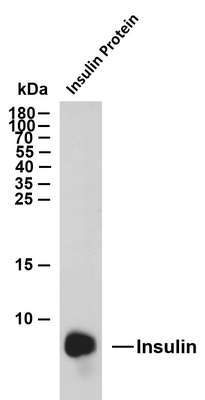Insulin (PT2015) mouse mAb
- Catalog No.:YM4889
- Applications:IHC;WB;IF;ELISA
- Reactivity:Human;Mouse;Rat;
- Target:
- Insulin
- Fields:
- >>MAPK signaling pathway;>>Ras signaling pathway;>>Rap1 signaling pathway;>>cGMP-PKG signaling pathway;>>HIF-1 signaling pathway;>>FoxO signaling pathway;>>Phospholipase D signaling pathway;>>Oocyte meiosis;>>Autophagy - animal;>>mTOR signaling pathway;>>PI3K-Akt signaling pathway;>>AMPK signaling pathway;>>Longevity regulating pathway;>>Longevity regulating pathway - multiple species;>>Regulation of actin cytoskeleton;>>Insulin signaling pathway;>>Insulin secretion;>>Ovarian steroidogenesis;>>Progesterone-mediated oocyte maturation;>>Prolactin signaling pathway;>>Regulation of lipolysis in adipocytes;>>Type II diabetes mellitus;>>Insulin resistance;>>Non-alcoholic fatty liver disease;>>Type I diabetes mellitus;>>Maturity onset diabetes of the young;>>Aldosterone-regulated sodium reabsorption;>>Alzheimer disease;>>Prostate cancer;>>Diabetic cardiomyopathy
- Gene Name:
- INS
- Protein Name:
- Insulin [Cleaved into: Insulin B chain; Insulin A chain]
- Human Gene Id:
- 3630
- Human Swiss Prot No:
- P01308
- Immunogen:
- Synthesized peptide derived from human Insulin AA range: 25-110
- Specificity:
- The antibody can specifically recognize human Insulin protein.
- Formulation:
- PBS, 50% glycerol, 0.05% Proclin 300, 0.05%BSA
- Source:
- Mouse, Monoclonal/IgG2b, kappa
- Dilution:
- IHC 1:200-1000. WB 1:500-2000. IF 1:100-500. ELISA 1:1000-5000
- Purification:
- Protein G
- Storage Stability:
- -15°C to -25°C/1 year(Do not lower than -25°C)
- Other Name:
- IDDM;IDDM1;IDDM2;ILPR;ins;INS_HUMAN;Insulin A chain;Insulin B chain;IRDN;MODY10;Preproinsulin;Proinsulin;Proinsulin precursor
- Molecular Weight(Da):
- 12kD
- Observed Band(KD):
- 9kD
- Background:
- Insulin is a hormone secreted by islet beta cells, which can promote the uptake and utilization of glucose by tissue cells, promote glycogen synthesis and reduce blood glucose. It is highly expressed in insulinoma and is mainly used for functional classification of islet cell tumor and auxiliary diagnosis of multiple endocrine tumors.
- Function:
- disease:Defects in INS are the cause of familial hyperproinsulinemia [MIM:176730].,function:Insulin decreases blood glucose concentration. It increases cell permeability to monosaccharides, amino acids and fatty acids. It accelerates glycolysis, the pentose phosphate cycle, and glycogen synthesis in liver.,function:Preptin undergoes glucose-mediated co-secretion with insulin, and acts as physiological amplifier of glucose-mediated insulin secretion. Exhibits osteogenic properties by increasing osteoblast mitogenic activity through phosphoactivation of MAPK1 and MAPK3.,function:The insulin-like growth factors possess growth-promoting activity. In vitro, they are potent mitogens for cultured cells. IGF-II is influenced by placental lactogen and may play a role in fetal development.,mass spectrometry: PubMed:12586351; PubMed:15359740,online information:Clinical information on Eli Lilly insu
- Subcellular Location:
- Cytoplasmic
- Expression:
- Blood,Liver,Muscle,Pancreas,
- June 19-2018
- WESTERN IMMUNOBLOTTING PROTOCOL
- June 19-2018
- IMMUNOHISTOCHEMISTRY-PARAFFIN PROTOCOL
- June 19-2018
- IMMUNOFLUORESCENCE PROTOCOL
- September 08-2020
- FLOW-CYTOMEYRT-PROTOCOL
- May 20-2022
- Cell-Based ELISA│解您多样本WB检测之困扰
- July 13-2018
- CELL-BASED-ELISA-PROTOCOL-FOR-ACETYL-PROTEIN
- July 13-2018
- CELL-BASED-ELISA-PROTOCOL-FOR-PHOSPHO-PROTEIN
- July 13-2018
- Antibody-FAQs
- Products Images

- Whole cell lysates were separated by 15% SDS-PAGE, and the membrane was blotted with anti-Insulin (PT2015) antibody. The HRP-conjugated Goat anti-Mouse IgG (H + L) antibody was used to detect the antibody. Lane 1: Insulin recombinant protein Predicted band size: 12kDa Observed band size: 9kDa

- Human pancreas tissue was stained with anti-Insulin (PT2015) Antibody

- Human pancreas tissue was stained with anti-Insulin (PT2015) Antibody

- Human pancreas tissue was stained with Anti-Insulin (PT2015) Antibody



